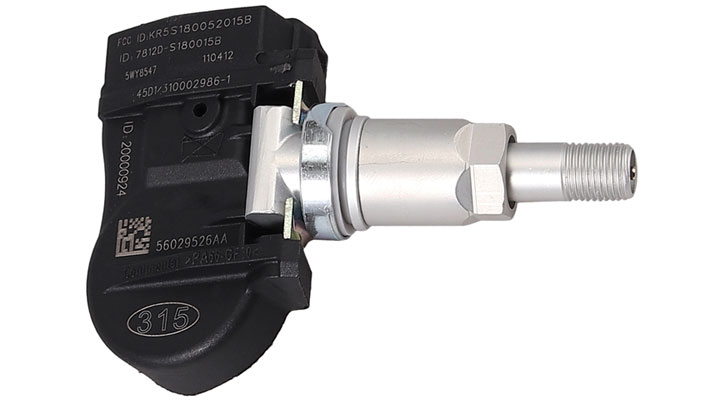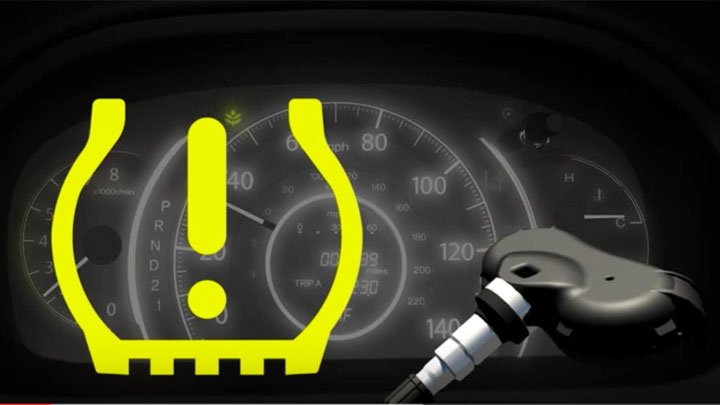Last Updated on June 1, 2022
You’ve probably been there before. While driving, your instrument cluster suddenly displays a “Tire Pressure Sensor Fault” message or warning light. But what exactly does it mean and how do you fix it?
What is a Tire Pressure Sensor?
A tire pressure sensor is a small computer located inside each tire. It is designed to alert drivers of an under-inflated tire. Tire pressure sensors, or TPMS for short, have been mandatory on all vehicles in the U.S. since 2007.
There are two common types of tire pressure sensors. The first is a valve type: the sensor and valve stem are one unit. The second is a band sensor: the sensor is mounted to the inside of the rim with a metal band.
Both sensors illuminate the dash light when the pressure reading is lower than it’s supposed to be, alerting the driver to a tire with low air pressure.
What Does a Tire Pressure Sensor Fault Message Look Like?

When a tire pressure sensor detects a problem with tire pressure, it will send a signal to the car’s computer, which will then illuminate a light on the dash.
This light is generally bright yellow, and looks like an exclamation point (!), inside of a “U” shaped symbol. This is the drivers warning to check on their tires, as one may be flat or just low.
See Also: Why is My TPMS Light On But My Tires Are Fine?
Can I Still Drive My Car?
Driving on an under-inflated tire can cause the vehicle to pull in one direction or the other, depending on which tire is low. This will cause the driver to have poor control over the vehicle, which is very dangerous.
Driving on a low tire can also at the least cause unbalanced tire wear and at most cause damage to the structural integrity of the tire, mainly the sidewall. This eventually can cause a blow out to occur once the tire is re-inflated. Driving on a completely flat tire will require that tire to be replaced due to this damage.
If you’ve confirmed that the tire pressure is adequate in all of the tires, then the the sensor has simply failed. At this point, the only concern the driver will have is the light glaring at them from the dash.
A failed sensor will require the driver to be more attentive to the pressure in their tires, since it is not reading the actual pressure anymore. This should be fixed at the earliest convenience for safety reasons.
Related: What To Do If You Get a Flat
The Fastest Fix

The quickest and easiest repair for this issue is to check the pressure of all the tires with a quality air pressure gauge. These gauges can be picked up at any parts store and even most gas stations.
Don’t forget to check the spare tire too! Many vehicles have a pressure sensor in the spare and it is often overlooked.
As little as 5 PSI under the manufacturer recommended pressure can cause the dash warning light to illuminate. The manufacturer recommended pressure can be found in the owners manual, or on a sticker located on the drivers side doorjamb.
Related: How Long Can You Drive on a Spare Tire?
To Replace or Not to Replace

If checking and adjusting the tire pressure to within the proper specs does not remedy the problem, chances are good replacing the tire pressure sensor is necessary. The failed sensor can be identified using an OBD2 scanner, or through the vehicle’s dashboard computer options, depending on the model.
While having an automotive scan tool will let you diagnose the problem yourself, you can always have a local tire or repair shop perform a scan to quickly identify which sensor has failed. The battery life of these sensors range anywhere from 2 to 10 years.
TPMS Sensor Replacement Procedure

In order to replace a failed tire pressure sensor, the wheel with the bad sensor must have the tire dismounted. Once the tire is off the rim, the old sensor can be removed and the new one installed.
After the new sensor is put in the rim, the tire will be remounted and inflated. Then comes reprogramming so the car’s computer will recognize it.
Since most car owners don’t have the capability to dismount and remount a tire, a trip to the local tire shop is necessary. Fortunately, the process isn’t very expensive and you can usually purchase the TPMS sensor cheaper on your own to save some money.
Sensing/Reprogramming the Sensor
The reprogramming process varies for each vehicle’s make and model. Some cars require a certain amount of mileage to be put on the new sensor for the computer to recognize it, usually just a couple miles.
Other vehicles must be reprogrammed using the same scanner that found the bad one. The scanner programs the sensor’s signal to the car’s computer so the two can communicate. Without this, the dash light will stay illuminated because the computer can’t read the new sensor, making reprogramming a crucial part of the replacement.
TPMS Sensor Replacement Cost
Best places to order parts? See: 19 Best Online Auto Parts Stores

The cost of a tire pressure sensor replacement varies with the car. The main cost of this repair is the sensor itself. Luxury brands, such as Audi and Land Rover, will have a much higher sensor cost than Ford, Honda, or Toyota, for example. These sensors can range anywhere from $50 up into the hundreds, for a single sensor.
The labor that goes into replacing the sensor is minimal, usually in the range of 1/2 to 1 labor hour per sensor. It is important to keep in mind, the cost of labor is different at all repair shops.
A big name dealership will have a higher hourly labor cost than a small family owned repair shop. Some shops will also charge a reprogramming fee. Always be sure to ask about hourly labor costs and reprogramming fees when looking for a place to replace the sensor.
Who’s Going to Fix It?
Choosing a place to have a repair of any sort done is solely up to the owner of the vehicle, and sensor replacement is no different! Of course, it is always recommended to choose a repair shop that is trustworthy and reputable. Avoid those shady places!
However, when it comes to tire pressure sensors, a big name dealership is not always the best choice either. A local tire shop should have the capability and knowledge to replace the sensor correctly.
Be sure to inquire about labor and part warranty when having any kind of work done at a shop. No one wants to spend money on a repair, just to find out the part was faulty or the labor done wrong.





I have a 2010 Ford F-150, every time I cross the same bridge at close to the same spot on the bridge the TPMS give me a Fault. Then after I have crossed the bridge after about an hour it goes off and stays off. Any ideas?
That’s strange. If your tire pressures are good it could be some interference from a nearby device? That’s just a wild guess though. Also the batteries could be on their way out if your TPMS system uses in-wheel sensors instead of the ABS sensors to monitor tire pressure.
Depending on what is in local area of the bridge and what is on the bridge itself. Any antennas on the bridge can effect the radio signal to the car from the TPMS sensor.
Also you stating that the TPMS fault codes go on. That would mean that some outside interference is causing the TPMS not be able to transmit to the OBD.
I would just check with a $40 OBD II reader from Walmart to make sure that a TPMS sensor is not failing. In more times the battery dies in these sensors and you MUST replace the entire sensor instead of just the battery. Because they weld the battery into the sensor most of the time.
Metal in tire maybe or devices on the bride are making it go off.I would not worry about it
$50? I’ll just ignore the light.
I have a 2008 Ford Explorer 4×4 6 cyl tpms lights are and truck is struggling to move is it hooked up to the abs?
I’m not sure. Was there a code to scan? Does it feel like it’s down on power, or like the ABS system is kicking in?
My 2010 ford f150 raptor does the same as coffee2010, and I have brand new sensors installed. Exact same symptoms. Ambient air temperature seems to affect the sensor, apparently only does this when it’s cold outside. Just got back from ford dealer, no problem found, have a nice day.
2007 Ford Explorer 4.6l 4×4 with 60,000 miles.Sensor only goes off on long trips. As soon as I turn off engine and turn it back on it resets. So how do figure out which one it is if it’s only on when driving long distance.?
I think those sensors are the kind that sit inside the wheels. They actually have a battery that will go out after a certain amount of time. If it’s been a while since you replaced the sensors, you may have to pull the sensors and replace the batteries.
I have a Toyota Camry 2015. Last year I purchased 4 tires and changed e bad tire sensors ( should have changed all 4). This year replaced car battery at different mechanic. Same day my TPMS light flashed for a minute then stayed on. Went back to same mechanic after trying the reset button and driving 50 miles..no luck. Took back to same mechanic as battery and says the other 2 sensors are bad. Replaced but could not code. Brought car back to try again..no luck. Now he has ordered 2 Toyota sensors. Still waiting for another appointment. I still think changing car battery messed up the computer but he says no. Hope he proves me wrong. Last year’s sensors were done at BJ’s but I no longer have membership to go back and I’m sure they didn’t have Toyota sensors. Any suggestions?
Changing the battery shouldn’t affect the sensors, aside from maybe needing a recalibration. Are you sure the original shop changed all the sensors?
Can a tire pressure sensor cause a blowout? I just had a blowout and the rim has nickel size hole in it from the inside to the outside. In other words, the edges of the hole in the rim are bent outward. There was a ripped hole in the side wall of the tire and the tires are less than a year old. Thoughts?
I have a 2017 Ford Fusion and the light came on tire pressure sensor I think it said fault anyone know what this is and is it safe to drive the car when the tire is low a picture of the car comes up showing each tire and the pressure in them this did not come up
Check your tire pressures. If they’re good, it’s probably safe to drive. You’ll know if your tire pressures are good if they match the tire pressure specification on the driver’s side door jamb. If one tire is lower than the rest, you probably have a puncture. Fill up the tires to the recommended spec and drive it to a tire shop if you have any concerns.